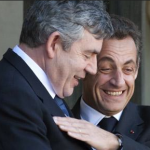Sarkozy and Brown called for a ‘new Bretton Woods’ in 2008
According to a IMF historian James M. Boughton the French President Nicolas Sarkozy and British Prime Minister Gordon Brown called for a ‘new Bretton Woods’ agreement in October 2008, shortly after the fall of Lehman Brothers. We quote mr. Boughton;
‘What Sarkozy and Brown envisaged was a new multilateral agreement to stabilize international finance in the 21st century, the way the 1944 conference, which established the International Monetary Fund and the World Bank, stabilized financial relations among countries in the second half of the 20th century. The summit meeting of world leaders held in Washington, D.C., in November 2008 started a process that could lead to such an agreement… On several occasions throughout the 20th century, political leaders in major countries sought international agreements on the global economic or financial architecture. Many of those efforts failed, Bretton Woods being the major exception. The central lesson that emerges from these efforts is that successful reform in response to a crisis requires three ingredients: effective and legitimate leadership combined with inclusive participation; clearly stated and broadly shared goals; and a realistic road map for reaching those goals.’
He also gave a few examples of past (proposed) resets;
Paris, 1918-19 – Although its main purpose was to redraw political borders and to establish principles for avoiding a repeat of the war, establishing a framework for restoring free trade and the flow of capital was also on the agenda…The economic goal of open trade and finance was widely shared, but how to achieve it was left unresolved because it was not the top priority at the conference. Agreement on a framework was scuttled by differences on war reparations, on the practical aspects of returning to the gold standard, and on the need for an international institution with oversight powers. The U.S. Congress declined to ratify participation in the new global institution, the League of Nations.
London, 1933 – Between the wars, the most ambitious event was the World Monetary and Economic Conference, held under the auspices of the League of Nations. It was preceded by two relatively successful meetings–one in Genoa in 1922 that re-established the gold standard for a group of mostly European countries, the other in Rome in 1930 that established the Bank for International Settlements. The 1933 London conference sought to re-establish fixed parities for a wider range of currencies. As with the League of Nations, this effort failed primarily because of a lack of support from the U.S. government. Three years later, the United States did sign an accord with France and the United Kingdom on a stabilization pact known as the Tripartite Agreement. That agreement, however, was an ad hoc effort to ward off a potentially competitive devaluation of the French franc.
Bretton Woods, 1944 – By mid-1942, the U.K.’s John Maynard Keynes and Harry Dexter White of the United States had prepared first drafts of their respective plans and had begun exchanging ideas to develop a common proposal before the end of the war. Preparations for what would become the Bretton Woods conference began in earnest in the middle of 1943. Keynes suggested limiting participation to a few countries, with the United Kingdom and the United States as “founder states” of the proposed institutions. This time the United States took the broader view. White insisted that delegations from all 45 allies in the war against the Axis be included and be given an opportunity to participate in the drafting sessions and in key decisions. Representatives of 18 countries met in Washington, D.C., in June 1943 to offer suggestions, and a 17-nation preparatory drafting conference was held in Atlantic City, New Jersey, in June 1944. All 45 delegations convened in Bretton Woods a few weeks later.
The full story can be found on the IMF website


